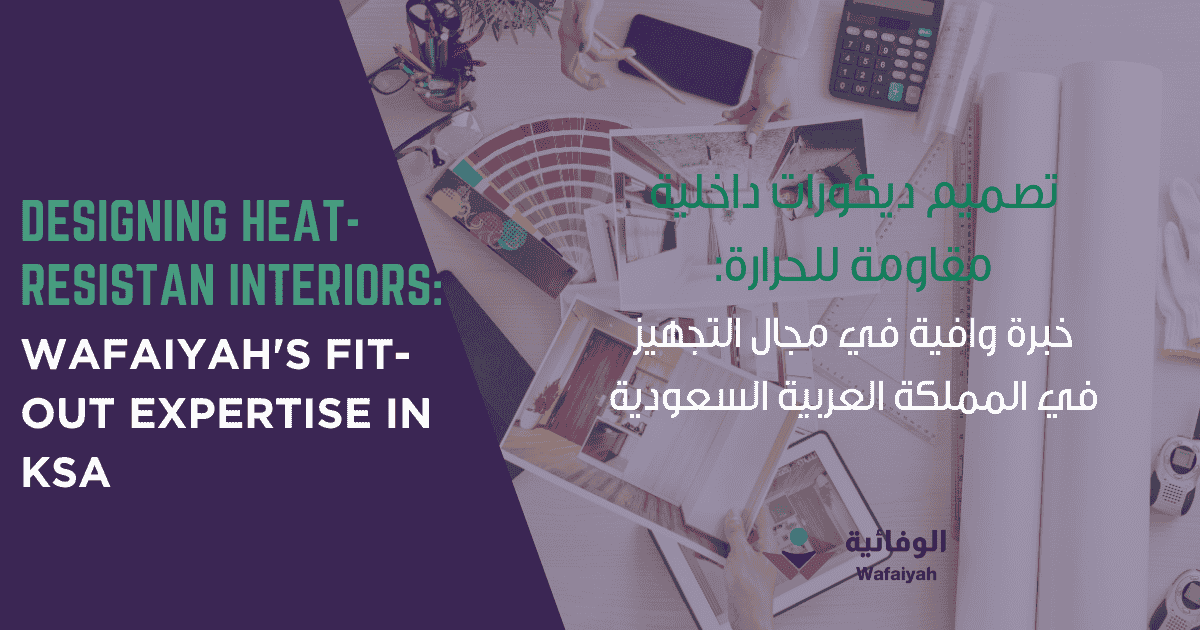Wafaiyah offers the best fit-out solutions that can deal with the immense Saudi heat while maintaining comfort and style. Our team incorporates advanced materials, smart thermal insulation, and creative design workflows that mitigate sun exposure and overheating risk. We utilize a diverse and detailed combination of design and application to deliver tailored fit-out solutions for commercial spaces and upscale luxury villa fit-outs. With many years of experience in and around KSA, we understand the unique demands of the region. When designing interiors, you can be sure our fit-out solutions will remain cool to the touch, standing strong against the elements.
Heat-resistant fit-out work is a thermal product exposed to extreme temperatures, potentially placing extreme thermal stress on key architectural elements. It is especially important in warm climates, like Saudi Arabia. Creating interiors that can resist exposure to the climatic environment also requires an acute understanding of high-performance interior materials, including thermal insulated wall panels, reflective wall panel systems, flame isolation ceiling systems, thermal insulated drywall, and so on.
A fit-out contractor is usually contracted to install low-emissivity (Low-E) glass or other UV protective glazing systems, heat-blocking window films, and low-energy or energy-efficient lighting to reduce the amount of internal heating and temperature build-up. Paint, surface finishes, materials, and bi-products used inside a space need to be resistant to fading and cracking in extreme heat. HVAC services for spaces to products provided must incorporate as much smart zoning as possible, with particularly insulated ducting and less exposed ducting. Furniture, fabrics, or textiles chosen must be specifically resistant to heat-related recessions and mainly resistant to wear. Every element, from design to delivery, is engineered to ensure thermal comfort, durability, and energy savings.
Why Designing Heat-Resistant Interiors in Saudi Arabia
Interior design for heat-resistant interiors in KSA entails constructing spaces that operate effectively in the extreme climate. The interiors begin with the appropriate materials: those that reflect heat rather than absorb it. Using decent insulation is essential to maintain the indoor temperatures. And of course, planning your layout smartly is used for controlling sunlight and humidity. In KSA, glass, paint, flooring, and ceilings need to be heat-resistant. Mechanical, electrical, and plumbing systems need to perform correctly and must be designed without overloading the mechanical system. This design promotes comfort and reduces costs and degradation associated with the sun.
Wafaiyah interior design solutions in Saudi Arabia
Wafaiyah provides advanced heat-resistant interior design solutions for the severe climate in Saudi Arabia. Using smart materials, thermal insulation, and efficient use of existing layouts, we assist in mitigating all heat effects. We provide professional fit-outfit-out services that ensure comfortable, durable, and energy-efficient spaces in residential homes, offices, and commercial spaces in KSA.
Smart Material Selection for Heat-Resistant Interior Design
Choosing the right materials plays an important role in providing heat resistance in the interior. The presence of reflective surfaces pushes heat away from surfaces. Rock, ceramics, and treated wood are good alternatives as they perform well at high temperatures; just avoid products that retain and trap heat. Fabrics should allow breathability, be UV resistant, and metallic coatings and cool roof membranes should also be used. Of course, walls, floors, and furnishings ought to be examined, too. Quality materials matter in a hot environment for longevity and comfort. This can help reduce the demand needed from cooling systems and help maintain a balanced ambient indoor temperature. When materials are chosen wisely, performance and aesthetics work better together to augment long-term savings and sustainability in extreme climate zones.
Thermal Insulation Techniques to Beat the Saudi Heat
Insulation is regarded as a means of minimizing the amount of heat transferred. Insulation with a high-R value should be applied to walls and ceilings. Insulation products such as spray foam, mineral wool, and reflective barriers are routinely chosen to fulfil this task. Sealing all gaps properly will also help manage heat intrusion, and you can add R-value by using double-layered drywall. Insulated panels are the best materials for large wall/roof areas. Thermal insulation will improve temperatures underfoot in the floor. If ductwork is involved in your project, please also use proper insulating methods on the ductwork. Proper insulation will effectively reduce energy use, therefore keeping your indoor space cooler and stable.
Energy-Efficient HVAC Integration in Interior Fit-Outs
Intelligent HVAC systems are critical for energy-neutral or energy-efficient interiors. Use zoning systems to cool only occupied spaces. Use programmable thermostats to increase building and user control. Use inverter-based air conditioners for better efficiency. Ensure that air duct systems are sealed and insulated. The placement of vents is important for good airflow. Use ceiling fans to help lessen the load on the HVAC system. Maintenance can also improve efficiency. Use HVAC in tandem with other building management systems. Identifying technologies that accommodate real-time monitoring and adjustment based on occupancy or environmental levels is a winning strategy. Regarding HVAC, being efficient in operations (and thus reducing energy expenditure) decreases not just your electric bill, but the strain on the system. Improvements and efficiencies that provide comfort, savings, and sustainability all work together.
UV-Resistant Finishes for Lasting Interior Surfaces
Ultraviolet light is responsible for fading, cracking, and the gradual degradation of many interior surfaces. Applying UV-resistant paints and finishes to painted and finished furniture is one simple and effective option. Laminates are available nowadays that include anti-UV protection. Window films can keep harmful sunlight rays from penetrating the interior of the building. Protective varnishes can be applied to most stained or painted wood. Look for UV-stable fabrics and textiles. There are also continuous flooring finishes that are treated to resist and protect against sun-related damage. Applying these finishes can prolong the life of your interior materials, keep colors bright, and save the surfaces from crippling deterioration. These types of applications will have the greatest impact in areas that will receive the most sunlight. Reducing the amount of maintenance and upkeep is a desirable result of any UV-resistant surface found in the commercial market.
Advanced Glazing and Window Solutions for Heat Control
Windows are the primary conduits for heat gain. Install double or triple glazing for expected improved insulation performance. Low-emissivity (Low-E) glass has heat-reflective properties. Tinted glass reduces glare and solar loads. Window films add an additional barrier. Install thermally broken frames to reduce heat bridging. Consider sunshades, blinds, or smart glass technologies—re-situate windows to avoid direct light. Skylights should incorporate heat-reflective coatings. No matter what you choose to use to treat glazing, the goal is to increase the overall comfort you feel inside the building. This will reduce the requirement for cooling systems and block harmful UV radiation. This is an effective improvement that both conserves energy and improves the performance of the building envelope.
Innovative Ceiling and Roof Treatments for Thermal Resistance
Ceilings and roofs can absorb considerable amounts of heat. You can use cool roof coatings to reflect direct sunlight. Some rooftops have radiant barriers that block heat transfer. If you have a particularly large ceiling surface, you may want to consider a ventilated ceiling application. If you have a thick ceiling, you should explore insulated roofing panels for your project. Generally, we use reflective paints on ceilings to reduce indoor temperature. Ceiling tiles can also be added with thermal padding, allowing the warmth to be absorbed in the roof cavity. You can reduce heat load on the building with roof gardens. Lighter textures of roofing materials play a role as well. Proper treatment can improve the energy performance of the roof. This will reduce cooling strain on your energy usage. The innovation involved in the roof as a treatment is one of the major factors in thermal comfort.
Sustainable Fit-Out Designs with Passive Cooling Elements
Passive cooling decreases heat without consuming energy. Aim to design the enclosure layout to maximise airflow. Take advantage of cross-ventilation to assist with the expulsion of hot air. Block direct sun by using shaded areas. High ceilings will assist with inducing passive cooling. Courtyards and areas that allow for open space can encourage ventilation. Install louvres for ventilation and roofs for exhalation (roof vents). Use a thermal mass material to help maintain indoor temperatures. Use light coloured materials and coatings to reflect heat. Utilising passive means combined with sensible insulation will decrease energy use & increase sustainability. The passive & building designs will be perfectly accomplished for hot climates. Passive cooling provides long-term comfort with low impact, offering a naturally efficient way to cool.
Fire-risk and heat-safe electrical installation
With increased heat comes a need for heat-safe electrical systems. The use of fire-rated cables and fire-rated conduits is important. Use fire-rated overload protection when configuring switchboards. Use flame-retardant insulation material. Provide appropriate protection through earthing and isolating all switching circuits. The use of enclosures to provide heat resistance is favourable. Provide smoke detection and thermal cut-off devices in electrical installations. Position electrical wiring away from heat source areas. Clearly labelled electrical circuits for compliance with safety are a necessary system. Regular inspection and thermal scanning are required. Eradicating fire risk through identified hot spots (short circuits) is the goal of using heat-safe hazard materials, configurations, and installations.
Advanced Engineering Solutions for Heat-Resistant Interior Fit-Outs
- Phase Change Materials for Temperature Regulation
- Cool Roofing Systems with High Solar Reflectance Index
- Smart Glazing with Electrochromic Glass
- Integrated Shading and Daylight Systems
- Raised Floors with Underfloor Air Distribution
- High-Performance Thermal Insulation Panels
Conclusion
Designing interiors that can withstand the extreme heat in Saudi Arabia requires expertise, innovation, and quality – Wafaiyah has all these. Our design, build, and fit-out solutions focus on smart materials, smart insulation, and smart thermal control designed for long-lasting performance. Regardless of whether it is an office environment or commercial interiors, we design and execute comfort without diluting style. Our team combines engineering with modern design to create energy-efficient, heat-resistant environments intended for the Saudi climate. Let us show you how to turn hot interior spaces into cooler functional spaces. Wafaiyah will help you with a custom fit-out consultation! Contact us today to discover smart interiors, durability, and performance!
Frequently Asked Questions
What makes your fit-outs heat-resistant?
We use smart materials, thermal insulation, and reflective finishes to reduce heat absorption and maintain cooler indoor temperatures—perfect for Saudi Arabia’s extreme climate.
Do you handle both residential and commercial projects?
Yes, our team delivers heat-resistant solutions for offices, homes, retail outlets, and other commercial spaces in KSA.
Are your materials energy-efficient and sustainable?
Absolutely. We prioritize eco-friendly materials that improve thermal performance, reduce energy consumption, and support sustainability goals in all fit-out projects.
Can I customize the design with heat-resistant features?
Yes, Wafaiyah offers fully customizable fit-outs, integrating heat-resistant technologies while aligning with your aesthetic, functional, and budget requirements.

